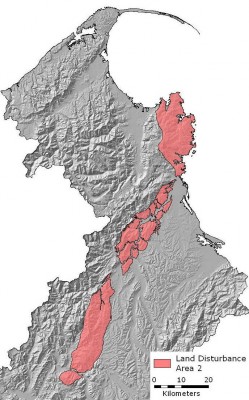Activities that disturb land must be adequately controlled to avoid sediment ending up in infrastructure and waterways. This page provides guidance on how to manage erosion and sediment on both large development sites and small building sites.
Erosion and Sediment Control Guidelines 2019 (pdf 15 MB)
The Erosion and Sediment Control Guidelines 2019 provides information on the technical tools and techniques to control erosion and sediment in the Tasman / Nelson region. It also provides a background on the issues, climate information and risks for the environment.
The individual chapters of the full guide can be downloaded below.
If you are considering undertaking land disturbance activities and require further information, please contact the Council's land compliance officer:
Sediment and contaminants from building sites can have a big impact on stormwater infrastructure and local water bodies.
Under the Building Act, site works are required to be managed to avoid impacts on neighbouring properties, infrastructure and downstream environments.
A short guide has been developed specifically for building sites and you can download the template for small site Erosion and Sediment Control Plan below. An ESC plan will become a standard requirement for all building consents.
Building Site Guide for Erosion and Sediment Control (pdf, 2.9 MB)
All concrete wash must be prevented from entering the Council stormwater system or waterways.
Concrete waste water is toxic. If it reaches streams and waterways, it will kill fish and plant life.
Management of concrete wash - full version (pdf, 450 KB)
Management of concrete washwater - truck driver (pdf, 227 KB)
Builder's Pocket Guide to working with concrete
Working with Exposed Aggregate presentation by Arrow International and ECAN
Concrete and cement are extremely toxic because they have a high lime content with a pH of 12 out of 14.
This can easily kill fish, eels and other wildlife. Never put concrete or wash concrete down stormwater drains.
Like all concrete run-off, wastewater from exposed aggregate is very toxic due to elevated pH levels.
Land disturbance occurs when the soil and covering vegetation is removed or disturbed. It includes excavating, infilling, recontouring, earthworks, trenching, and quarrying.
Land disturbance can be a result of road works, recontouring for subdivision, excavation of building foundations, retaining walls, trenching of underground services - anything where ground is moved or altered.
Land disturbance can have serious negative effects - soil loss or damage, soil instability, sediment mobilisation and subsequent deposition and contamination of waterways.
Such disturbances may adversely affect natural ecosystems or impact archaeological sites and often require resource consent.
There are a range of land disturbance good practices and sediment control measures available to limit the impact on the environment.
The undertaking of land disturbance activities is controlled by rules in the Tasman Resource Management Plan (TRMP). Land Disturbance activities can range from minor vegetation removal to large earthworks associated with major subdivision projects. Some activities may be undertaken as a Permitted Activity subject to complying with the relevant rules within the TRMP, whereas others may require a resource consent.
The land disturbance rules in the TRMP are found in section 18.5.
Further detail on the issues, policies and objectives underlying these rules are in chapter 12 of the TRMP.
This document is a collection of national and international good practice guidelines, legislation, spatial information, research and funding options all relevant to forestry, land management and environmental protection.
The intended audience is everyone from private landowners, small forest owners, iwi and commercial forestry companies.
Resources for Erosion and Sediment Management in Forestry – Te Tau Ihu.pdf (pdf 1.4 MB)
The Nelson-Tasman Land Development Manual contains requirements for how erosion and sediment controls are to be included in land development projects, including the requirement for Erosion and Sediment Control Plans.
The Separation Point Granites are readily eroded when exposed. Particular care is needed during earthworks and with stormwater control.
Here we provide details of the location and properties of Separation Point granites.
The Separation Point granites are a strip of granitic bedrock about 10 kilometres wide that extends for over 100 kilometres from Abel Tasman National Park in the north to Mt Murchison in the south.

Map of Land Disturbance Area 2 showing Separation Point granites
At the land surface this rock is deeply weathered. This weathered surface can be up to several metres in depth and is extremely erodable and readily breaks down to its constituent components forming a coarse sand. It is sand derived from these rocks that form the golden beaches of Abel Tasman National Park.
Because of the highly erodable nature of the Separation Point Granites particular care is needed when undertaking any form of land disturbance. In particular, all stormwater needs to be appropriately controlled and any areas of exposed soils stabilised.
The extent of the Separation Point Granite terrain is mapped as Land Disturbance Area 2 in the Tasman Resource Management Plan planning maps. There are specific rules pertaining to land disturbance activities undertaken on this geology.
Land disturbance activities often result in the mobilisation of sediment that inevitably ends up in waterways if adequate control measures are not adopted. There are specific rules in Tasman Resource Management Plan that address sediment control associated with land disturbance.
There are a range of land disturbance practices and sediment control measures available to limit the impact on the environment. The Council's Engineering Standards contain guidelines for erosion and sediment control.
Nelson Tasman Land Development Manual
Auckland Council has great information and videos about sediment control.
Building site management guide from Auckland Council
Small sites buidling brochure from Auckland Council
Find useful guidance at http://bpg.co.nz/
Management of concrete washwater - truck driver.pdf (pdf 227 KB)